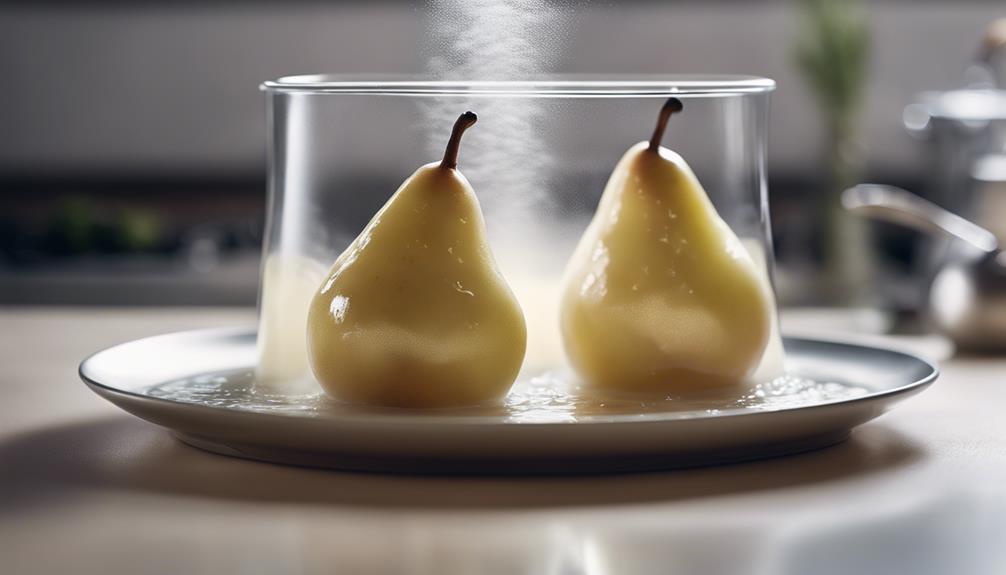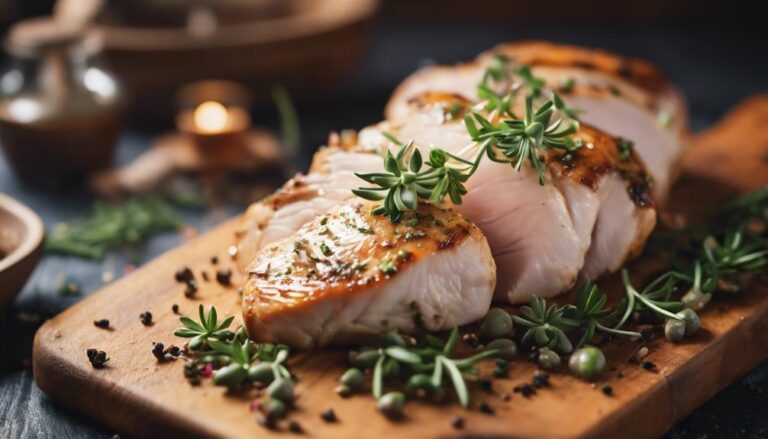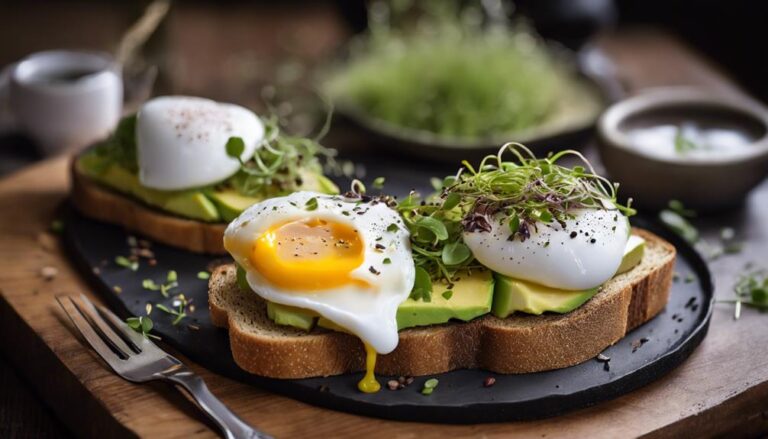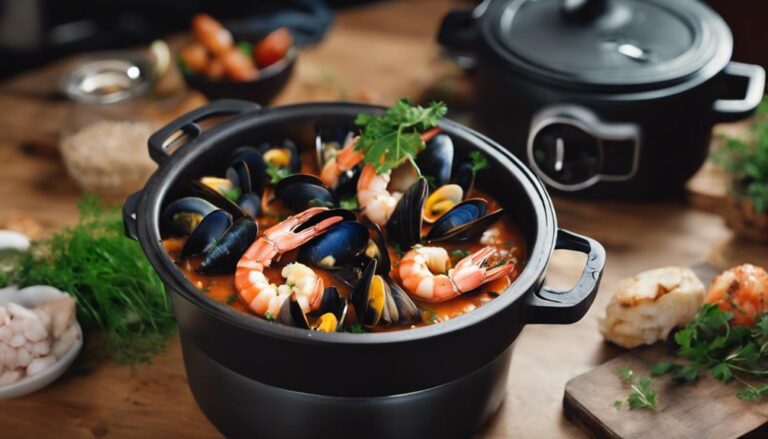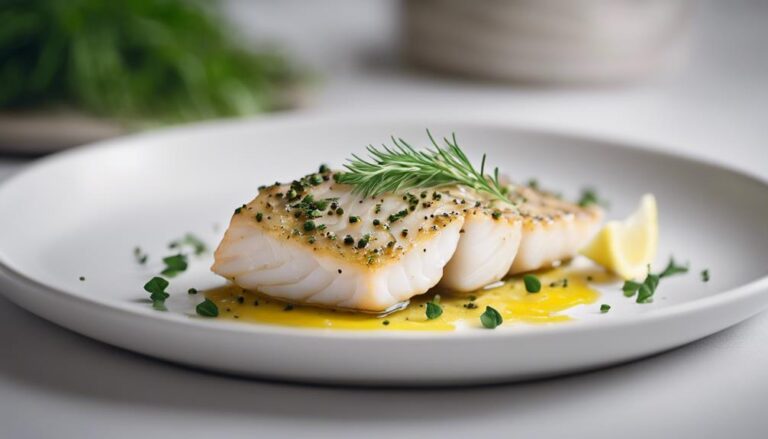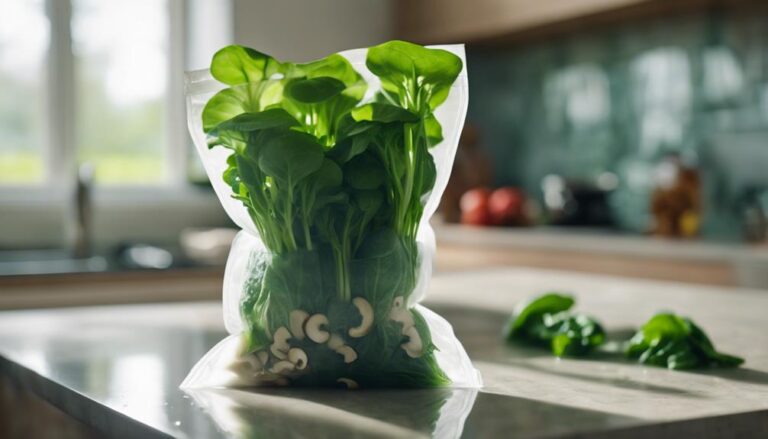Zero-Point Sous Vide Poached Pears
To master zero-point sous vide poached pears, you'll start by selecting firm, slightly ripe Bosc or Comice pears. These varieties maintain their shape and absorb flavors best. Prepare your poaching liquid from sugar syrup enhanced with vanilla, aiming for a warm, complex aroma. Set your sous vide precisely to 80°C to guarantee the pears achieve perfect tenderness while preserving their nutrients and structure. Consider including sweet white wine or star anise to infuse additional layers of flavor. Serving the pears with a decadent hot chocolate sauce transforms this dish from simple to extraordinary. Exploring further may reveal even more surprising ways to perfect this dish.
What You Will Learn Here
- Sous vide poached pears offer precision cooking at 80°C, ensuring perfect tenderness and flavor retention.
- Utilize sugar-free sweeteners to achieve a "zero-point" dessert suitable for diet-conscious individuals.
- Select firm, slightly ripe Bosc or Comice pears for best results in shape and texture retention.
- Flavor can be enhanced with spices like cinnamon or star anise, without adding caloric value.
- Serve with a zero-calorie sweetener-infused chocolate sauce for an indulgent yet health-conscious dessert.
Pear Poaching Origins
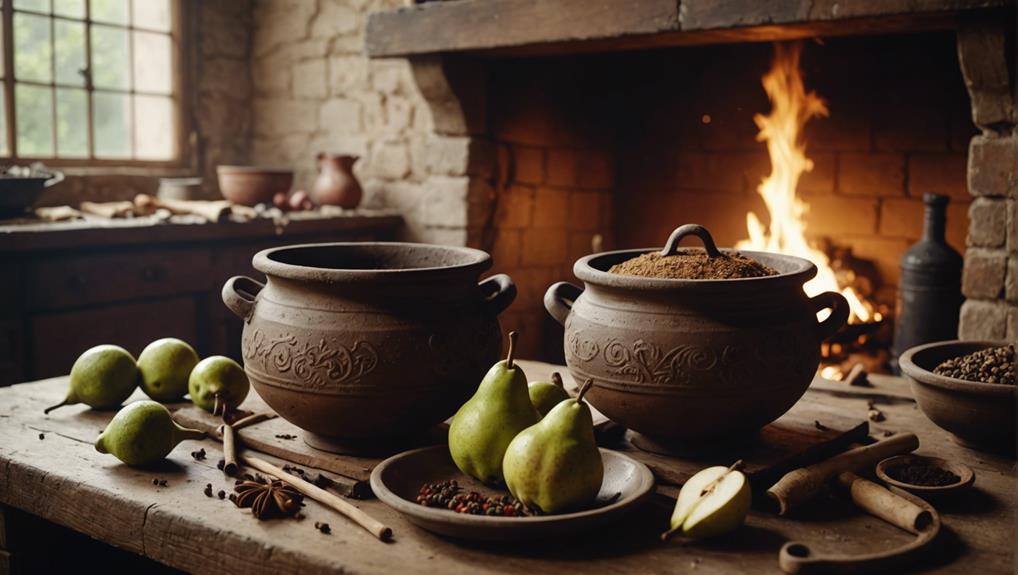
You'll find that pear poaching isn't a modern-day culinary innovation but rather a practice rooted deeply in history.
Examining how historical methods have evolved, it's clear that techniques from Roman and Medieval times have been refined to enhance flavor and preservation through sous vide technology.
This shift underscores a fusion of cultural culinary practices with contemporary precision cooking.
Historical Pear Poaching
Did you know that the culinary tradition of poaching pears dates back to ancient times, with evidence found in Roman and medieval European cuisines? This method, initially utilized to preserve and enhance the flavor of pears, has been refined over centuries.
Traditionally, pears were poached by simmering them in a concoction of water, sugar, and spices. This method was especially prized in aristocratic circles during the Renaissance, incorporating luxurious ingredients like saffron and rosewater to elevate the dish's elegance and taste.
As you explore the art of pear poaching, consider how techniques have transformed, particularly with the advent of sous vide, which guarantees precise temperature control for consistently perfect poached pears.
Cultural Culinary Techniques
Exploring the origins of pear poaching uncovers a rich tapestry of culinary techniques that have evolved across different cultures, each adding its own unique twist to this ancient practice. Traditionally, you'd find the method involving a simple syrup, where sugar is dissolved in water, creating a base in which pears are gently cooked. However, as you investigate further, you notice variations. Some cultures infuse the syrup with vanilla, enhancing the flavor profile dramatically.
In your quest to serve others, adopting the sous vide technique elevates this practice. By sealing pears with vanilla and sugar in a vacuum, and immersing them in a controlled water bath, you guarantee flavors are deeply infused, achieving a consistency and richness unattainable through conventional methods.
Evolution of Poaching Methods
Throughout history, culinary methods have continually evolved, with poaching serving as a prime example of innovation in food preparation techniques. Originally, you might've seen food gently simmered in liquid on a stove, a method perfected during the times of the Roman Empire and medieval Europe.
However, the introduction of modern techniques like sous vide has revolutionized this process. Sous vide poaching epitomizes precision, allowing you to maintain exact temperatures, ensuring consistent results and superior flavor infusion.
This evolution from traditional to modern poaching methods not only highlights advancements in culinary technology but also enhances your capability to serve dishes that are both sophisticated and delicately prepared, like sous vide poached pears.
Essential Poaching Ingredients
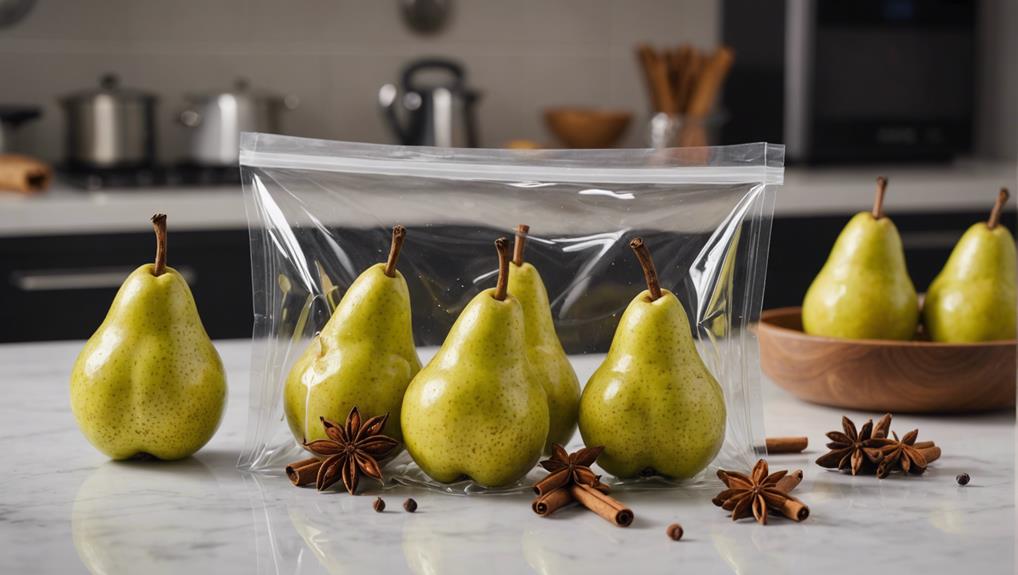
To achieve the ideal flavor and texture in sous vide poached pears, you'll need essential ingredients like sugar syrup, vanilla, and ripe pears. Sous vide, a method you've chosen for its precision, allows you to maintain the integrity and enhance the natural sweetness of the pears. As you commence on this culinary experiment, consider the impact of each ingredient on your final dish.
When poaching pears using the sous vide technique, your primary goal is to infuse the fruit with flavors that complement its natural essence. Here are three important components you should focus on:
- Sugar Syrup: Acts as the base of your poaching liquid. Its density and sweetness level can be adjusted to suit the desired outcome. You might experiment with different types of sugar—white, brown, or even honey—to vary the flavor profile.
- Vanilla: A classic flavor enhancer that introduces a warm, complex aroma. The type of vanilla used—be it extract, bean, or paste—will affect the subtlety or intensity of the vanilla notes in your poached pears.
- Ripe Pears: The choice of pear variety is critical. Opt for types that retain their structure while cooking but are also capable of absorbing the aromatics from your poaching liquid. Pears like Bartlett or Bosc are excellent choices for their balance of texture and flavor absorption capabilities.
Through this analytical approach, you're not just cooking; you're curating an experience for those you serve. Each choice reflects your commitment to delivering a refined, meticulously crafted dish. By controlling the variables in your sous vide process, you safeguard that each pear is a tribute to both your skill and your dedication to flavor excellence.
Top Pear Poaching Formulas
You'll find that each pear poaching formula offers unique characteristics:
Classic Cinnamon Vanilla enhances the fruit's natural sweetness with a comforting warmth, while the Spiced Red Wine option introduces a rich, complex flavor profile.
The Chai-Spiced recipe infuses the pears with aromatic spices, elevating the sensory experience.
Classic Cinnamon Vanilla Poached Pears
Let's explore how the precise and controlled cooking of sous vide transforms simple ingredients like pears, cinnamon, and vanilla into an exquisitely tender and flavorful dessert. By employing the sous vide technique, you're ensuring that the pears are cooked uniformly without the risk of overcooking. Here's what makes the classic cinnamon vanilla poached pears a standout choice:
- Temperature Precision: Sous vide allows for exact temperature control, ensuring the pears sous vide absorb the cinnamon and vanilla essence thoroughly without losing their texture.
- Flavor Infusion: The vacuum-sealed environment intensifies the flavors of spiced poached pears, deeply embedding the aromatic profiles into the fruit.
- Versatility in Serving: Serve these decadent pears warm with a scoop of vanilla ice cream or chilled as a delightful end to a meal.
Spiced Red Wine Poached Pears
Immersing pears in a rich blend of red wine and selected spices not only enhances their natural sweetness but also imparts a complex flavor profile, making Spiced Red Wine Poached Pears a sophisticated dessert choice. When you poach pears sous the spiced red wine method, you're diving into an experimental culinary technique that maximizes flavor extraction and texture perfection.
Here's how you can achieve this:
- Select the Right Pears: Opt for firm, ripe pears which hold up well during the cooking process.
- Spice Blend: Experiment with cinnamon, star anise, and cloves to find the perfect balance that complements the red wine.
- Reduction Technique: After poaching, reduce the poaching liquid to create a rich, flavorful syrup perfect for drizzling.
This method not only elevates the humble pear but also provides a delectable treat for your guests to enjoy.
Chai-Spiced Pear Poaching Recipe
After exploring the rich flavors of Spiced Red Wine Poached Pears, we now turn our attention to the aromatic world of Chai-Spiced Pear Poaching, a method that infuses pears with the essence of warm, inviting chai spices. This approach not only enhances the fruit's natural sweetness but also offers a comforting, exotic touch.
Here's how you can achieve this delectable dessert:
- Prepare your spices: Mix ground cinnamon, cardamom, and cloves—key chai elements that provide a deep, aromatic flavor.
- Vacuum seal: Place the pears and mixed chai spices into a vacuum bag, ensuring an even distribution for optimal infusion.
- Sous vide process: Cook at a precise temperature to maintain texture while allowing the chai spices to permeate thoroughly.
Serve these poached pears with hot chocolate sauce for a delightful contrast of flavors.
Optimal Pear Poaching Techniques
To optimize your pear poaching technique, you'll need to select your pears carefully; firmness and ripeness can have a notable impact on cooking times and final texture.
Setting your sous vide to the precise temperature of 80°C allows for the ideal softness while preserving the pear's inherent flavors.
Experiment with various flavor infusions by adjusting the concentrations of spices or types of sugar, which can subtly or dramatically alter the taste profile of your poached pears.
Pear Selection Criteria
Choosing firm, slightly ripe Bosc or Comice pears guarantees they maintain their shape and texture when poached. For your poached pears, you'll need to carefully select firm pears that are ripe yet resilient enough to withstand the gentle heat of sous vide without disintegrating.
Avoid overripe pears; they're prone to becoming mushy, compromising the elegant presentation and texture you're aiming for. Look for pears with a clean, unblemished skin, as any imperfections could affect the final appearance of your dish.
Temperature and Time Settings
Setting your sous vide device to precisely 80°C (176°F) guarantees that your pears are poached to perfection, balancing texture and flavor ideally. At this temperature, the poached pears reach an ideal balance, becoming tender while maintaining their structural integrity. It's essential that you adhere strictly to the cooking time range of 20-30 minutes. This window ensures that the pears are heated through but not overcooked, preserving their natural sweetness and vibrant texture.
| Temperature (°C) | Cooking Time (Minutes) |
|---|---|
| 72 | Below 20 |
| 80 | 20-30 |
| 85 | Above 30 |
| 80 (Ideal) | 20-30 (Best) |
This precise control over temperature and time is important for delivering consistently excellent results.
Flavor Infusion Techniques
Experiment with different sugars like honey, Demerara, or molasses to enrich the flavor of your poached pears. Dive further into the art of flavor infusion by introducing sweet white wine into your poaching liquid. This choice not only elevates the sweetness but also integrates a sophisticated dimension to the dish. Incorporating star anise can offer a licorice nuance that complements the natural sweetness of the pears, enhancing the overall profile of your dessert.
For an exceptional finale, consider serving your poached pears with hot chocolate sauce. The contrasting temperatures and the richness of the chocolate create a sensory delight. Each component you choose can transform the simple act of poaching pears into an exquisite culinary experience.
Final Thoughts
You'll find that Zero-Point Sous Vide Poached Pears offer a uniquely satisfying dessert experience, perfectly balancing health with indulgence. By utilizing the sous vide technique, where pears are vacuum-sealed and gently poached in their own juices, the flavors and nutrients are impeccably preserved, creating a dish that's both nourishing and delightful. Particularly when served with hot chocolate sauce, these poached pears transform into a decadent yet guilt-free treat.
Let's explore further into why this method is ideal for serving a sublime dessert:
| Aspect | Benefit |
|---|---|
| Nutrient Retention | Sous vide cooking ensures that vitamins and minerals in the pears are not lost during the cooking process. |
| Flavor Intensity | The vacuum seal locks in flavors, intensifying the natural sweetness of the pears. |
| Texture Control | Cooking at precise temperatures guarantees that the pears are perfectly tender, not mushy. |
| Caloric Control | Using zero-point ingredients means the dessert can be enjoyed without calorie concerns. |
| Versatility | This technique allows for experimentation with different spices and flavorings without overpowering the delicate fruit. |
In this analytical exploration, we've seen that the sous vide method isn't just about cooking—it's about enhancing while preserving, experimenting while ensuring results, and indulging while staying health-conscious. As you prepare this dish for others, remember that each element from temperature to timing plays a critical role in achieving the perfect balance. Serve these poached pears knowing you're offering a sophisticated, thoughtful dessert that caters to both the palate and well-being.
Frequently Asked Questions
Should Pears Be Peeled Before Poaching?
Yes, you should peel pears before poaching to enhance flavor absorption and improve textural impact. While peeling removes some nutrients, the benefits in taste and presentation for your guests are significant.
Can You Poach Underripe Pears?
Yes, you can poach underripe pears. They'll face texture challenges, but adjusting ripening methods and sous vide settings enhances flavor absorption. Experiment to serve others with perfectly tender and tastefully enhanced pears.
At Which Stage of Ripeness Should Pears Be for Poaching?
For poaching, select pears at a stage where firmness supports shape retention during the ripening process, ensuring peak flavor development. This choice guarantees a superior culinary experience for those you're serving.
How Can You Keep the Pears Completely Covered by the Poaching Liquid?
To keep the pears submerged, use the vacuum sealing benefits and liquid displacement method, ensuring temperature control for consistent results. This approach helps you serve perfectly poached pears to your guests.
Conclusion
Now, you've navigated through the art of pear poaching, from its rich origins to the precise techniques that elevate this simple dish.
Using ideal temperatures and key ingredients, you've explored how scientific precision enhances culinary outcomes.
Embrace these experimental insights as you refine your approach, continuously adjusting variables to perfect your craft.
Remember, each pear offers a unique canvas for your culinary experiments, blending tradition with innovation in every succulent bite.
